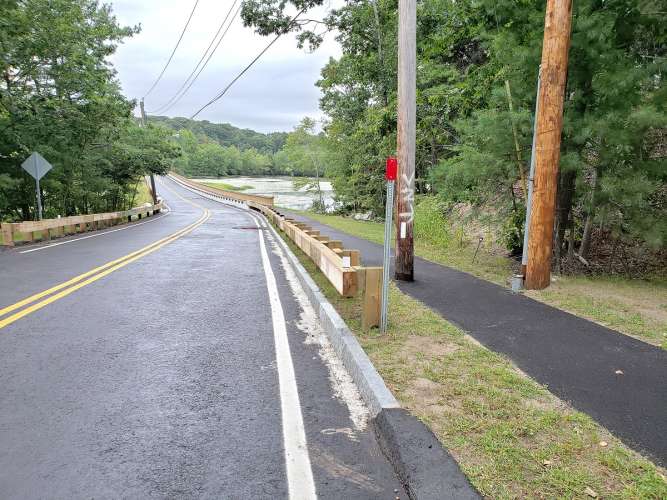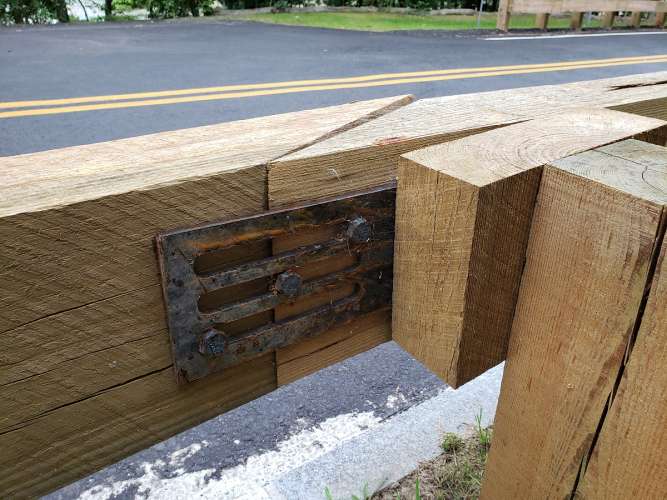The image at the top of our story shows a modern guard rail end cap system saving a life. Or having saved a life, more accurately. Guard rails can save your life in some circumstances, but in others, they can be deadly. New designs are helping to reduce injuries and deaths when motorists hit the end cap of a guard rail. “Highway safety goes beyond vehicle design, and improvements in roadway design play a vital role in preventing crashes or mitigating the severity of those crashes that do occur," said Joseph Young, spokesperson at the Insurance Institute For Highway Safety (IIHS).
Guard rail end caps were particularly deadly in past years because they could resist the impact of a vehicle. They were built to take a load from the side, not the end. The ends, called “end terminals” by designers, were anchored in the ground firmly. When a motorist would lose control and strike the end cap, the guard rail could either stop the car abruptly, resulting in huge forces on the occupants, or worse, penetrate the vehicle cabin. “Guard rails are, of course, designed to keep a vehicle from leaving the roadway and striking other objects or encountering embankments, said Mr. Young. “But they operate as a larger system that includes end treatments that need to dissipate energy in the event that they’re struck head-on.”
The National Highway Traffic Administration (NHTSA) has a long listing of end terminal disasters where the occupants are harmed by guard rail end cap strikes gone wrong. The most horrific include images of guard rails through driver’s seats. New guard rail designs are such that the end of the guard rail end terminal isn’t a hazard itself. They are designed to give way in a predictable manner, reducing the G forces of the crash to lower levels. More importantly, they are designed so that they curl back and don’t penetrate the cab of the vehicle that strikes them.
The image at the top of our story is interesting not just because it displays so perfectly how the guard rails are designed by engineers to work, but because that end cap was in place for a very short time before it was struck. The location of this accident was on a stretch of New Hampshire highway where undamaged older designs are being replaced with the new end caps. The new end cap was in place less than a month before it did its job. In fact, the guard rail replacement project on this road was on wasn’t even completed before the updated end cap was put to use. Luckily for the vehicle occupants, the replacement started at the end that was struck.

It isn’t just the classic ribbon of steel guard rails that are now safer. More aesthetically pleasing wooden guard rails are also being updated to include end caps that can give way, rather than stop a vehicle abruptly. If you look closely at the image above, you will see that the guard rail posts near the end of the line are drilled at their base to have a large hole. This lowers their breakpoint in the direction of the guard rail, while still providing enough strength to do their job if the vehicle hits them along their length. Can you pick out the other two ways these systems are designed to move when struck from the image below?

Guard rails are designed to keep vehicles from leaving the roadway and striking fixed objects, rolling down an embankment, entering a body of water, or hitting other vehicles head-on. Drivers hit guard rails for a long list of reasons. Avoiding animal strikes, after losing traction in poor weather, after having been hit by another vehicle, and of course, from lack of control due to speed, impairment, or attentiveness. Advances in roadway guard rails design can save more lives than in the past. The next time you see workers replacing undamaged sections of guard rails, you will now know why they are doing so.
John Goreham is a long-time New England Motor Press Association member and recovering engineer. John's interest in EVs goes back to 1990 when he designed the thermal control system for an EV battery as part of an academic team. After earning his mechanical engineering degree, John completed a marketing program at Northeastern University and worked with automotive component manufacturers, in the semiconductor industry, and in biotech. In addition to Torque News, John's work has appeared in print in dozens of American news outlets and he provides reviews to many vehicle shopping sites. You can follow John on TikTok @ToknCars, on Twitter, and view his credentials at Linkedin
Re-Publication. If you wish to re-use this content, please contact Torque News for terms and conditions.
Images by John Goreham












